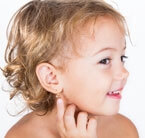
When parents ask pediatricians about having their newborn's ears pierced, how should they respond?
Pediatric resident Suzanne Rossi had heard the questions more than once from parents of a newborn, usually at the 2- or 4-month wellness check: "When can I have my child's ears pierced? Are there any risks involved?"
Not fully informed herself, she looked into literature on the subject, which she found to be sparse on infants, and shared her findings at a recent Children's Center Grand Rounds. The American Academy of Pediatrics (AAP), she noted, has one major recommendation: Postpone ear piercings until the child is mature enough to take care of the pierced site herself.
"That's clearly the best way to reduce the risk of infection," Rossi said.
Despite the risks, for cultural and other reasons many families move ahead with ear piercing, in which a 12-to-18 gauge needle is passed through the body part and jewelry is inserted in the hole. In those cases, Rossi noted, the AAP recommends that gold posts be used to reduce the risk of an allergic reaction and inflammation in the area of the piercing, and that rubbing alcohol or antibiotic ointment be applied to the area three times daily for a few days to reduce the risk of infection. Parents should leave the earring in for 4 to 6 weeks, and gently rotate it each day. Needless to say, the AAP recommends that the procedure be done by a trained professional under sanitary conditions.
Complications also include the formation of keloids, noted Rossi, pointing to a small 2005 study in which 80 percent of the patients developed the unsightly growths after being pierced at age 11 or older (Pediatrics 2005;115:1312)
The researchers recommended that patients prone to keloid formation from personal or family history do not undergo piercing. If that's not possible, they recommend piercing before the age of 11.
Other complications of ear piercing include-
- Bleeding
- Contact allergies
- Post traumatic tearing, which is more common with dangling earrings
- Deformation of the auricle, which more common with higher ear piercings
- Embedded backings
- Infection and purulent discharge, which occurs in 24 percent of all ear piercings.
Rossi also noted that pediatricians need to be mindful of certain patient populations, like children with congenital heart disease (CHD), in which the consequences of a piercing related infection could be much more serious. Among a group of physicians who care for adolescents and adults with CHD, 53 percent disapproved of ear piercing. Of those, 60 percent believed antibiotic prophylaxis was indicated (Journal of Adolescent Health 1999;24:160-162).
"But the message was not well communicated as only 6 percent of patients took antibiotics prior to piercing," said Rossi.
Rossi concluded, "At this point practitioners really need to form their own opinions about ear piercing. I usually try to recommend to families that they get past the six month immunizations to reduce their risk of tetanus and blood borne infections. We also make sure the parents are taking them to a reputable place to decrease the risk of infection."
For more on piercing complications, see "Should we say NO to body piercing in children?" (International Journal of Dermatology 2011;50:467-469)
